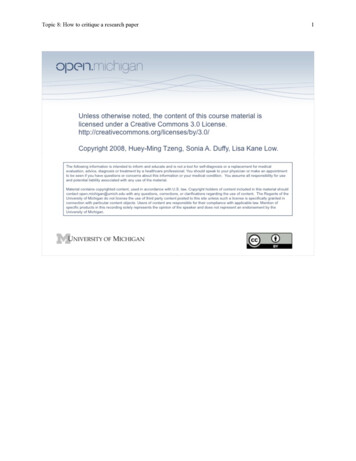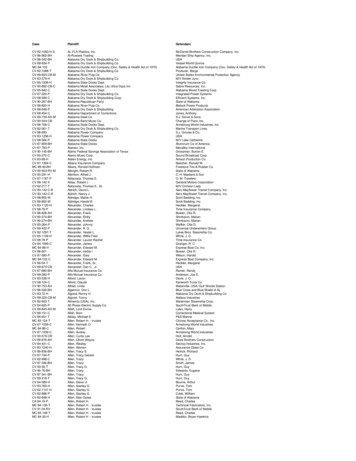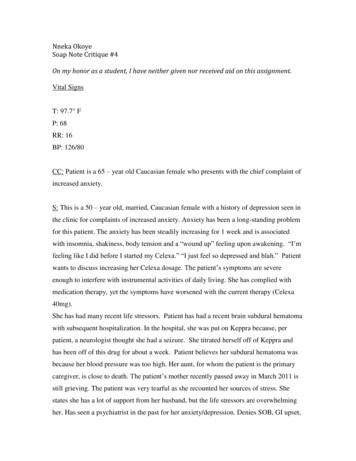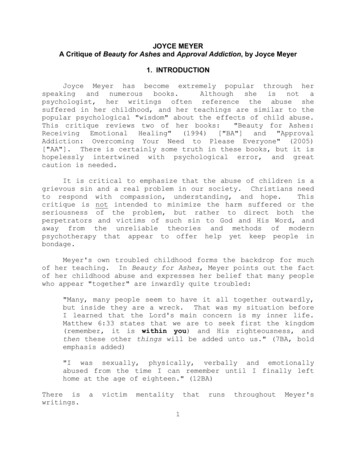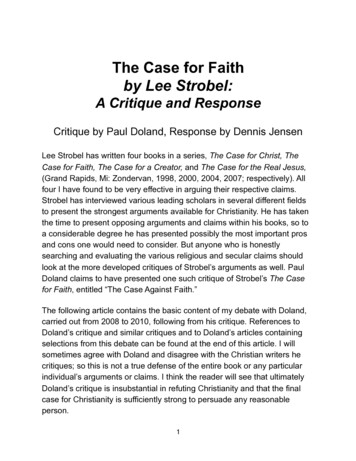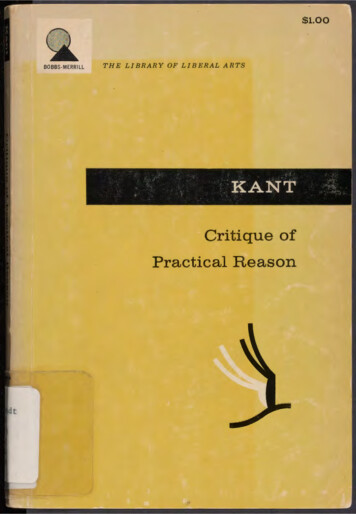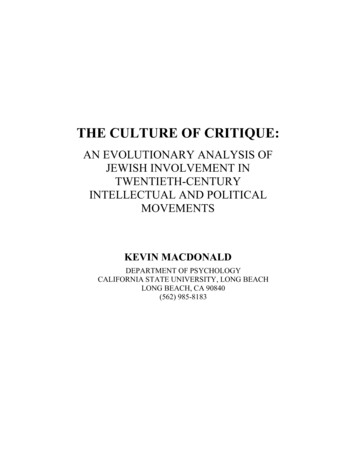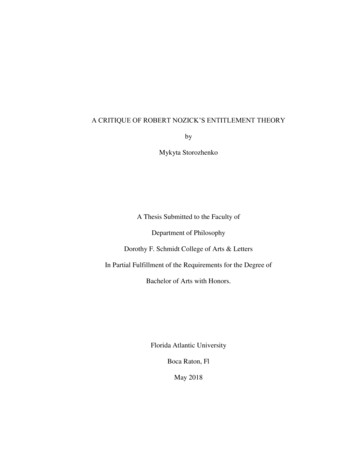
Transcription
A CRITIQUE OF ROBERT NOZICK’S ENTITLEMENT THEORYbyMykyta StorozhenkoA Thesis Submitted to the Faculty ofDepartment of PhilosophyDorothy F. Schmidt College of Arts & LettersIn Partial Fulfillment of the Requirements for the Degree ofBachelor of Arts with Honors.Florida Atlantic UniversityBoca Raton, FlMay 2018
A CRITIQUE OF ROBERT NOZICK’S ENTITLEMENT THEORYbyMykyta StorozhenkoThis thesis was prepared under the direction of the candidate’s thesis advisor, Dr. ClevisHeadley, Department of Philosophy, and has been approved by the members of hissupervisory committee. It was submitted to the faculty of the Philosophy Department andwas accepted in partial fulfillment of the requirements for the Honors distinction.SUPERVISORY COMMITTEE:Clevis Headley, Ph.D.Thesis AdvisorMarina P. Banchetti, Ph.D.Dateii
ABSTRACTAuthor:Mykyta StorozhenkoTitle:A Critique of Robert Nozick’s Entitlement TheoryInstitution:Florida Atlantic UniversityThesis Advisor:Dr. Clevis HeadleyDegree:Bachelor of Arts with HonorsYear:2018Robert Nozick’s entitlement theory is seen as the preeminent theory of libertariandistributive justice. It is my intention, however, to demonstrate the various flaws inherentwithin his theory as follows: (1) I will examine his whole entitlement theory, as well asthe accompanying addendums which he uses to amplify the theory; and (2) offer amultifaceted critique of the entitlement theory and its addendums. The focus of mycritique is that Nozick constructs a theory upon premises which are never clearlyexplained and remain vague. They are, therefore, unfit for the construction of a plausibletheory of distributive justice.iii
A CRITIQUE OF ROBERT NOZICK’S ENTITLEMENT THEORYIntroduction .1Chapter One .3Chapter Two .13Section One 13Section Two .20Section Three .23Chapter Three .27Section One 27Section Two .36Section Three .40Conclusion .43Bibliography .44
INTRODUCTIONLiberalism is the predominant paradigm within English-speaking social andpolitical philosophy. The paradigm of liberalism that has become prevalent is groundedin the works of John Rawls and this paradigm has been critiqued and reformulated byother thinkers. However, many scholars often forget or ignore the works of RobertNozick. The issue with the scholars’ forgetfulness and ignorance is that rarely doesforgetting about something, or all together ignoring it, makes that something go away ordisappear. The libertarians have not gone away, though they have shifted the discourseby assimilating themselves into various seemingly centrist or neo-liberal factions. Thedanger of ignoring these libertarians is that their ideas often go unchallenged. If they arechallenged, the challenge is presented indirectly, such that it only assaults the peripheralelements of their beliefs. The ultimate result is that the core ideology of libertarianismremains relatively intact. While I am not by any means implying that the libertariansocial and political philosophy of Nozick, or other less well-known libertarian, isinherently problematic, I do hold that libertarian theory is flawed.The goal of this thesis is twofold.My first goal is to provide an in-depthexamination of Robert Nozick’s libertarian theory, particularly his entitlement theory, forit is the fundamental core of not only his distributive justice theory, but also hislibertarian theory at large. The in-depth examination of Nozick’s theory of justice willdirectly follow his writings in Chapter Seven of his Anarchy, State and Utopia. The1
second goal is to provide a critique of the entitlement theory to make sure that its flawsare clear and undeniable.2
CHAPTER ONERobert Nozick’s Entitlement TheoryThe best way to understand and expose Robert Nozick’s libertarian entitlementtheory is to look at the way in which he starts Chapter Seven of Anarchy, State andUtopia, the chapter in which he delineates his theory of justice. The term “distributivejustice” is, for the large part, seen as a label for justice in property, social goods, andwelfare distribution. Nozick states that “the term ‘distributive justice’ is not a neutral one.Hearing the term ‘distribution,’ most people presume that some thing or mechanism usessome principle or criterion to give out a supply of things.”1 One would be right toquestion who “most people” are who presume that the term “distributive justice”presupposes a central distribution mechanism or apparatus. Nozick never explains whothese “people” are, though he does attempt to back up his claim by stating thatredistribution is always inherent within the term “distribution,” and that if we allow forsuch definition, we must conclude that “we are not in the position of children who havebeen given portions of pie by someone who now makes last minute adjustments to rectifycareless cutting. There is no central distribution.”2 My interpretation of what Nozick isattempting to claim is that to use the term “distributive justice” implies that we are likechildren arguing about the shares of pie bestowed upon us by some sort of all-powerfuldistributor, of which there is no kind. Not only is there not an all-powerful distributor,there are no bestowed shares either, because “what each person gets, he gets from others12Robert Nozick, Anarchy, State and Utopia, 2nd ed. (New York, NY: Basic Books, 2013), 149Ibid.3
who give to him in exchange for something, or as a gift.”3 It appears to me that forNozick, any given outcome of property within society is neither generated by an allpowerful authority, nor is the property in question bestowed in a vacuum. Rather, theproperty distribution that exists is a complex function of exchanges, trades, and gifts.Nozick offers a witty and clever metaphor, stating that “there is no more a distributing ordistribution of shares than there is a distributing of mates in a society in which personschoose whom they shall marry.”4 In his metaphor, it seems that Nozick is comparing theorganic emergence of love among people to his idea that property holdings emergeorganically among people. It appears that for Nozick, love is metaphorically similar toproperty, which perhaps illuminates why libertarians seems to “love” property so much.Nozick does acknowledge that some individuals who use the term “distribution” to referto justice in property ownership patterns “do not imply a previous distributingappropriately judged by some criterion.”5 He does maintain that “despite the title of thischapter [“Distributive Justice”], it would be best to use a terminology that clearly isneutral.”6 Nozick may be a challenging philosopher, but by no means is he an iconoclast.In determining a more fitting name for his justice theory, he argues that “we shall speakof people’s holdings; a principle of justice in holdings describes (part of) what justicetells us (requires) about holdings.”7 It appears that for Nozick, the label “DistributiveJustice,” in reference to justice in property ownership patterns, ought to be replaced by“Justice in Holdings.” We can conclude that the topic, and the reason for Nozick’s3Ibid.Ibid, 1505Ibid.6Ibid.7Ibid.44
entitlement theory, is his attempt to formulate an adequate theory of justice in holdings,and definitely not a theory of distributive justice.Now that Nozick’s intention to formulate a theory of justice in holdings is clear,we can examine his actual theory. He states that, “the subject of justice in holdingsconsists of three major topics,” indicating a tripartite, namely: (1) topic of originalacquisition of holdings, (2) the topic of transfers of holdings, and (3) the topic ofrectification of injustice in holdings.8 Though the theory is a tripartite, it soon shall beclear that the core of the theory rests within the second topic. In providing a descriptionof the first topic of justice, Nozick states the following:The first is the original acquisition of holdings, the appropriation ofunheld things. This includes the issue of how unheld things may come tobe held, the process, or processes, by which unheld things may come to beheld, the things that may come to be held by these processes, the extent ofwhat comes to be held by a particular process, and so on. We shall refer tothe complicated truth about the topic, which we shall not formulate here,as the principle of justice in acquisition.9The purpose of the principle of original acquisition or, in other words, the principle ofjustice in acquisition, is to explain how things in the world become property. The notionof property carries with it the presupposition that in order for a thing to be property itmust be owned, either by an individual, a group, or in common with others communally.But how does something that is unowned become owned? How can something that isunowned suddenly become private and exclusive? There is often exclusion andownership inherent within property and that must be explained, which Nozick claims the89Ibid, 150, 152.Ibid, 1505
principal of original acquisition will do. First, it must be understood that for Nozick, thereexist things in the world that are originally neither owned by one individual, nor by acommunity. Only if we accept the implicit axiom of original non-ownership can we allowNozick to further define the means by which these unowned things in the world becomeowned, or, in other words, property. Nozick explicitly states that he will not formulateand explain the principle of justice in acquisition within the entitlement theory, whichshould, without a doubt arouse, suspicion as to the validity of the principle. However, heamplifies the principle of justice in acquisition with the Lockean Proviso.Now that the purpose of the topic of original acquisition or, as Nozick calls it, theprinciple of justice in acquisition, is made clear, I am going to provide an explication ofhis second topic. Regarding the second topic of justice in holdings, Nozick states thefollowing:The second topic concerns the transfer of holdings from one person toanother. By what processes may a person transfer holdings to another?How may a person acquire a holding from another who holds it? Underthis topic come general descriptions of voluntary exchange, and gift and(on the other hand) fraud, as well as reference to particular conventionaldetails fixed upon in a given society. The complicated truth about thissubject (with placeholders for conventional details) we shall call theprinciple of justice in transfer.10The topic of transfer of holdings, or the principle of justice in transfer, can be understoodas Nozick’s attempt to provide an account of the way in which property may betransferred among people, presumably to justify the free market. He tells us that this topicdeals with the mechanisms in which transfers are made, offered and requested, the10Ibid.6
intricacies of gift giving and fraud, and how societal norms may factor into the equation.Though it may not be evident now, due to the fact that Nozick avoids directly explainingit until later, the topic of justice in transfer is central to his theory of justice.After my examination of Nozick’s discussion of original acquisition of holdingsand the of transfer of holdings, the careful reader will see that two of three topics havenow been made clear, and there is surely an expectation of a third topic. However,Nozick adds another section within his entitlement theory in order to reinforce thevalidity of the first two principles of justice in holdings. In attempting to do so, he statesthe following:If the world were wholly just, the following inductive definition wouldexhaustively cover the subject of justice in holdings.1. A person who acquires a holding in accordance with the principle ofjustice in acquisition is entitled to that holding.2. A person who acquires a holding in accordance with the principle ofjustice in transfer, from someone else entitled to the holding, is entitled tothat holding.3. No one is entitled to a holding except by (repeated) application of oneand two.The complete principle of distributive justice would say simply that adistribution is just if everyone is entitled to the holdings they possessunder the distribution.11It appears that if Nozick could indeed establish that the world was entirely just, theentitlement theory would only consist of the first two premises. In the first premise, hestates that assuming a person initially acquires property in a just way, the property11Ibid, 1517
belongs to the said person. It is unfortunate that he in no way alludes as to what is justinitial acquisition. Based on the second premise, a transfer of property is just if it is inaccordance with the principle of justice in transfers, a principle he has yet to delineate orexplain. The third and final premise concludes the theory, arguing that justice in propertyis derived through entitlement, which itself can only be validly deduced from premise oneor two. It becomes clear that for Nozick, justice, in the context of property, is derived notthrough the way in which it is distributed but, rather, through the preservation ofentitlement to property. The theory is radical in that the only thing that matters inevaluating whether a distribution of property is just is merely whether someone has anentitlement to said property, and, in order to confirm the validity of an entitlement, allthat one must do is check to establish whether or not the said entitlement arose inconformity with Nozick’s principle of justice in acquisition or his principle of justice intransfer. He further attempts to strengthen his entitlement theory by introducing ananalogy between justice in holdings and logic. He states that “a distribution is just if itarises from another just distribution by legitimate means Whatever arises from a justsituation by just steps is itself just.”12 In other words, Nozick appeals to the metaphor oflogical validity to reinforce his entitlement conception of justice. He states the following:As correct rules of inference are truth-preserving, and any conclusiondeduced via repeated application of such rules from only true premises isitself true, so the means of transition from one situation to anotherspecified by the principle of justice in transfer are justice-preserving, andany situation actually arising from repeated transition in accordance withthe principle from a just situation is itself just.131213Ibid.Ibid.8
Nozick seems to be arguing that, as long as property is acquired and repeatedlytransferred in accordance with the principles of justice, then any pattern of distributionresulting from the transfer is just regardless of the consequences of the said distribution.After all, since logical conclusions are valid for as long they necessarily follow from truepremises, then it must be that distributions are just, for as long as the distribution isarrived by just means—in this case, through the principles of justice.Recall that in his addendum to the entitlement theory, Nozick stated that the firsttwo principles of justice would suffice for an adequate account of justice in holdings ifthe world were just. However, the world, without a doubt, is riddled with past injustices.Concerning the problem of history, Nozick states that “justice in holdings is historical; itdepends upon what actually has happened.”14 In fact, some scholars argue that the rise ofprivate property was always through violence, conquest, and force. In other words, mostproperty hitherto was acquired originally through means that violated the principle ofjustice in acquisition. Moreover, any repeated transfers that occurred hitherto areillegitimate as well, for they were not justly acquired in the first place. Nozick knows thisof course, and while addressing the issue of historical injustices, he states that, “theexistence of past injustices (previous violations of the first two principles of justice inholdings) raises the third major topic under justice in holdings: the rectification ofinjustice in holdings.”15 As with the previous principles, the principle of rectificationmust address certain, critical questions. He raises some of these questions, asking thefollowing questions with regard to the principle of rectification of justice in holdings:1415Ibid, 152Ibid.9
If past injustice has shaped present holdings in various ways, someidentifiable and some not, what now, if anything, ought to be done torectify these injustices? What obligation do the performers of injusticehave toward those whose position is worse than it would have been hadthe injustice not been done?. How, if at all, do things change if thebeneficiaries and those made worse off are not the direct parties in the actof injustice, but, for example, their descendants?. How far back must onego in wiping clean the historical slate of injustice?16These questions, without a doubt, are paramount in constructing a framework for how theprinciple of rectification of past injustice ought to work. Nozick queries whether pastinjustices have had an impact on current holdings. He further questions the notion ofobligations, and if there are any. There are also questions of transference of obligationsand, moreover, the question of how far back to go. Nozick considers these questionsfundamental to constructing a proper theory of rectification. After a brief inquiry into thescope of the principle of rectification, Nozick states that he does “not know of a thoroughor theoretically sophisticated treatment of such issue.”17 Nozick does speculate on thepossibility of such principle or theory. He states:Idealizing greatly This principle uses historical information aboutprevious situations and injustices done in them (as defined by the first twoprinciples of justice and rights against interference), and information aboutthe actual course of events that flowed from these injustices, until thepresent, and it yields a description (or descriptions) of holdings in thesociety. The principle of rectification presumably will make use of its bestestimate of subjunctive information about what would have occurred ifthe injustice had not taken place. If the actual description of holdings turnsout not to be one of the descriptions yielded by the principle, then one ofthe descriptions yielded must be realized.1816Ibid.Ibid.18Ibid, 152-31710
It is interesting to note that Nozick does not speak of the other two principles of justice inholdings in such technical language or careful details. However, what he said can besummarized as follows: the principle of rectification ought to examine historicalinjustices and then adjudicate the difference between the current holdings as they are nowvis-à-vis holdings as they would have been had the injustice not occurred. The reason thatNozick uses careful language when discussing the rectification principle can never beknown. Of course, it is possible to argue that he did not want to include any specificinformation about how such a principle would work, and how far back it could beapplied. Moreover, one ought to note that he reduces the question of past injustices downto bare holdings or, in another word, property. Questions of lost lives and livelihoods,diminished quality of life, and even borderline genocide are ignored. This developmentseems to confirm a shared notion about libertarians: for them, the only legitimatequestions concern property and only property.Concluding the first section of the chapter on distributive justice, Nozicksummarizes his theory and states that “the general outlines of the theory of justice inholdings are that the holdings of a person are just if he is entitled to them by theprinciples of justice in acquisition and transfer, or by the principle of rectification ofinjustices.”19 Simply put, there is justice in holdings if and only if all property holdingsare found to be in accordance with the principles of justice, namely, the principle ofjustice in acquisition and the principle of justice in transfers. Any careful reader would beconfused at this point, particularly about the fact that Nozick asks us to accept a theory ofjustice based on principles that he never clearly explains, or provide clear guidance fortheir implementation. Nozick knows that there are tensions, and attempts to alleviate the19Ibid, 15311
said tensions by stating that in order to complete the theory, one “would have to specifythe details of each of the three principles of justice in holdings.”20 It is my view, however,that the specification of the three principles of justice in holdings are not just necessaryfor completing the theory but, rather, are paramount to the fundamental primacy of thetheory itself. Nozick argues that the house, or, in this case his theory of justice inholdings, is almost complete, and all it needs are the foundation, support beams, and thewalls. It has a roof, or, in other words, the conclusion that one ought to do with one’sproperty as one sees fit for as long as there is entitlement to the said property; however,Nozick’s house has no strong foundation upon which to build his conclusion. It is a roofresting on baseless pillars and nothing else. Though Nozick, in reference to theincompleteness of the entitlement theory, states that, “I shall not attempt this task here,”in which “this task” means the explication of the three principles of justice in holdings, hedoes in fact go on to argue further in favor of his theory. While these addendums to histheory of justice in holdings are not core components of the entitlement theory, nor arethey explicit attempts to further explain the empty principles of justice that he covets,they can, nevertheless, be plausibly integrated into and intertwined into his entitlementtheory. This point follows because these addendums are intended to serve as examples ofthe theory at work.20Ibid.12
CHAPTER TWOAddendums to the Entitlement TheoryAfter delineating the structural components of his entitlement theory, while at thesame time refusing to offer substantive details about exactly how the said structuralcomponents would operate, Nozick adds five sections in hopes of clarifying some of theideas that form the foundation of the principles of justice in holdings. The five sectionsthat Nozick incorporates are as follows: (1) Historical Principle and End-ResultPrinciples; (2) Patterning; (3) How Liberty Upsets Patterns; (4) Locke’s Theory ofAcquisition; and (5) The Proviso. For purposes of this thesis, I will condense thesesections as follows: Historicity and Patterning, Liberty and Transfers, and the LockeanProviso. Though Nozick does not explicitly state that these sections, or addendums as Ishall refer to them here, are explicit amplifications of his entitlement theory, theircontent, as I shall show, serves to clarify the principles of the entitlement theory, namely,the first and the second principles.212. 1: Historicity and PatterningImmediately after delineating the principles of justice in holdings that comprisehis entitlement theory, Nozick offers the reader further information regarding how theIt should be noted that Locke’s Theory of Acquisition and the Proviso are exceptions, as Nozick doesstate that they amplify the first principle of justice in holdings.2113
entitlement theory relates to history and distribution patterns that are inherent within anytheory of distributive justice. He says that “the entitlement theory of justice in distributionis historical; whether a distribution is just depends on how it came about.”22 Thehistorical nature of the entitlement theory is evident in that whether a holding is just isevaluated on the basis of whether property was originally acquired justly, namely, inaccordance with the principle of justice in acquisition, and whether any proceedingtransfers were just, meaning in accordance with the principle of justice in transfers.Nozick offers a comparison here. He states that “in contrast [to his entitlement theory],current time-slice principles of justice hold that the justice of a distribution is determinedby how things are distributed (who has what) as judged by structural principle(s) of justdistribution.”23 The time-slice theory evaluates justice in holdings based on structuralprinciples that dictate whether a distribution is just, and the historical theory evaluatesjustice in holdings based on the justice of transfers and acquisitions, not on the endresults. Nozick further clarifies the distinction. He states that “according to a currenttime-slice principle, all that needs to be looked at, in judging the justice of a distribution,is who ends up with what; in comparing any two distributions one need look only at thematrix presenting the distributions.”24 Often, a current time-slice principle is used toargue against wealth inequality and wealth disparity on the basis of a value judgementconcerning how wealth should be distributed among the members of a population. If agiven distribution conforms to the pattern established by the principle, then thedistribution is just. A historical theory, namely the entitlement theory, does not concernitself with the way in which property is distributed; it does not care who owns what,22Ibid.Ibid.24Ibid, 1542314
insofar as the result is arrived at in accordance with the justice preserving principles: theprinciple of justice in acquisition and the principle of justice in transfers. Accordingly,wealth disparity, no matter how significant or large, is irrelevant within the entitlementtheory. As a means of supporting the importance of historical tracking to a distributivejustice theory, and his intent to discretely denigrate current time-slice principles, Nozickasks us to consider imprisonment:If some persons are in prison for murder or war crimes, we do not say thatto assess the justice of the distribution in the society we must look only atwhat this person has, and that person has, and that person has, at thecurrent time. We think it relevant to ask whether someone did somethingso that he deserved to be punished, deserved to have a lower share. Mostwill agree to the relevance of further information with regard topunishments and penalties.25In other words, when looking at the number of people in prison and examining theirproperty possessions or rights or status, which presumably is lower than that of a freeindividuals, we must not forget that these people did something to end up in prison, and,therefore, their status and property possessions ought not to make up the whole of ourdeliberation regarding the justice of their status or possessions. In other words, prisonershave less because, as a consequence of their actions, they deserve less. Hence, the factthat they have less ought not be the sole factor in determining justice. A historicallysensitive theory should take into account the reason why the people in question are inprison, and use this reason to account for why they have lesser property holdings incomparison to those who are free. However, a current time-slice principle would merelyuse a principle to adjudicate the justice of the distribution in accordance with the said25Ibid.15
principle, with no regard for the way in which the distribution was reached. According toNozick, the principles of justice that operate in accordance with a current time-sliceprinciple of justice are to be referred to as end-result or end-state principles. He furtherstates that unlike end-result principles, the “historical principles of justice hold that pastcircumstances or actions of people can create differential entitlements or differentialdeserts to things.”26 Consequentially, these differentials are completely justified, nomatter the disparity.The terms “pattern” and “patterns” have come up repeatedly within the precedingdiscussion, and rightfully so, because Nozick uses these terms as a means for furtherclarifying the entitlement theory. In reference to the entitlement theory’s principles ofjustice, he states that “to better understand their precise character, we shall distinguishthem from another subclass of historical principles.”27 After introducing an example of aproperty distribution principle being based on individual moral merit, where anindividual’s holdings correlate to the same individual’s moral merit, whatever that maymean, Nozick states the following:Let us call a principle of distribution patterned if it specifies that adistribution is to vary along with some natural dimension, weighted sumof natural dimensions, or lexicographic ordering of natural dimension.And let us say a distribution is patterned if it accords with some patternedprinciple.28What Nozick seems to mean when he uses the term “patterned distribution” is adistribution that accords with a principle that is based on a natural dimension, be it moral26Ibid, 155.Ibid, 155-628Ibid, 156.2716
merit or I.Q. As an example, a given society with a distribution pattern operatingaccording to I.Q. or moral merit will exhibit a pattern where those with a higher I.Q. orgreater moral merit will have more holdings, and those with a lower I.Q. and lesser moralmerit will have less holdings. Nozick states that “almost every suggested principle ofdistributive justice is patterned: to each according to his moral merit, or needs, ormarginal products, or how hard he tires, or the weighted sum of the foregoing, and soon,” all in contrast to his entitlement theory, which is not patterned. 29 Nozick does admitthat in a society that operates in accordance to the entitlement theory, it is inevitable that:heavy strands of patterns will run through it; significant portions of thevariance in holdings will be accounted for by pattern-variables. If mostpeople most of the time choose to tra
3 CHAPTER ONE Robert Nozick's Entitlement Theory The best way to understand and expose Robert Nozick's libertarian entitlement theory is to look at the way in which he starts Chapter Seven of Anarchy, State and Utopia, the chapter in which he delineates his theory of justice.The term "distributive

